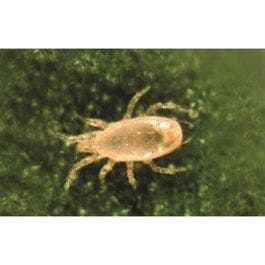Thing is in the outdoors there are so many predators that eat spider mites that if you don't use pesticides the predators will do their job
Here is a list of twelve predators that eat hundreds a day
Spider mites see plant leaves as food and gain nutritional value from sucking the sap of these plants which eventually lead to wilting, drooping, and death. Other insects see spider mites as food and as well gain nutritional value from hunting, killing, and feeding on spider mites, which considerably reduces their population in a particular location.
Call it a cycle of pests and diseases, call it karma, call it whatever, you will still be right. This is probably nature’s way of sustaining balance in the ecosystem. The cycle of life.
Various insects predate, kill and feed on spider mites. This article outlines only twelve of the predators that eat spider mites. Namely:
- Galendromus occidentalis
- Persimilis
- Stethorus Punctillum
- Ambyseius Swirskil
- Mesoseiulus longipes
- Neoseiulus fallacis
- Green lacewings
- Ladybugs
- Predatory thrips
- Whiteflies
- Orius
- Feltizila
These predators are so active that they can kill up to a hundred spider mites in a day. The use of natural predators for the control of pests and diseases isn’t only cheaper than pesticides and herbicides, it is also a sustainable technique.
1. GALENDROMUS OCCIDENTALIS
The galendromous occidentalis is a biological control agent of pest mites on plants. It is usually smaller than the spider mites and shaped like a pear.
They are adapted to take on the color of their prey. They are usually born white and take color on their first feeding. So it is difficult to say if the galendromus occidentalis is white, black, yellow, or brown.
They usually attack the two-spotted species of spider mites and therefore take up that color. This predator feeds on all the stages in the life cycle of the two-spotted spider mites. It does not also feed on plants and can reproduce as quickly as spider mites.
One galendromus occidentalis can kill about 25 spider mites in a day. This number, multiplied by a colony of galendromus occidentalis, equals complete ridding of the plants of pests and diseases of spider mites.
You can readily purchase this predator from botanists and entomologists.
If you no longer want the predators on your plants after the eradication of spider mites, You can eradicate them by the use of pesticides as they are susceptible to chemical control.
2. PERSIMILIS
Persimilis are shaped like a back sack and are adapted to feed on every spider mite species, especially the two-spotted spider mites.
The persimilis adult predator feeds on every stage of the spider mite life cycle. They can feed on the eggs, larvae, pupa as well as Imago of the spider mites.
This is easily done using their method of engulfing.
Persimilis are better adapted for the control of spider mites in cold regions given that they can withstand considerable amounts of frost. They are also the best predators for a plant with lots of leaves infested with spider mites.
It is advisable to release a little number of persimilis predator on a plant infested by spider mites. This is to enable the persimilis to develop and reproduce on the plant in line with the natural conditions of the plant.
This way, they are well adapted to the immediate environment, which makes them more effective in getting rid of spider mites pests, and diseases.
3. STETHORUS PUNCTILLUM
This predator is a smaller-sized beetle native to Africa, Europe, and Asia. They have been nicknamed spider mite destroyers, because of how effective they are in eradicating these pests and diseases from plants.
These predators attack adult spider mites and kill them in a little while. They can be gotten in commercial quantities and added to the soil without having to take caution about their eating up plant leaves.
They are better applied to the plant alongside one or two other predators to boost their effectiveness.
4. AMBYSEIUS SWIRSKIL.
This predator is effective on a long list of pests and diseases that attack plants. It behaves like the spider mites in its mode of development and growth on plants.
The amblyseius swirskii lives on the underparts of plants and can easily infiltrate spider mite cocoons. They attack the spider mite eggs by laying their eggs inside the spider mite eggs.
This causes a hybridization hatching that kills the eggs. They also attack and kill adult spider mites within days of being introduced to the plant.
Ambyseius Swirskil is a biologically engineered pests and diseases controller and can only be bought from the labs.
5. MESOSEIULUS LONGIPES
The mesoseiulus longipes is a spider mite predator that is usually red-orange and about 0.5cm long. It stays on the underparts of its prey where it lays its eggs that gain dominance of the plant.
After complete dominance is gained, it attacks spider mites, feeding on both grown-ups and their eggs until there are no more spider mite pests and diseases on the plant.
This predator is entirely carnivorous and has no business feeding on plant leaves.
6. NEOSEIULUS FALLACIS
It is characterized by an ability to predate on a large species of pests and diseases with the spider mite included.
It feeds on generally every species of spider mites and can work better in the early stage of a spider mite infestation just before the spider mites cover the whole plant.
7. GREEN LACEWINGS
The green lacewings are botanically called Chrysopidae. They are a voracious insect species that attack a wide list of plant pests and diseases.
Usually green in color, they are often difficult to detect which offers them camouflage in their predatory process. They feed on spider mites as well as other parasites of plants and occasionally perch on humans to suck their blood.
They are a naturally occurring spider mite predator and do not need to be genetically engineered and imported into the plant leaves.
Gardeners can attract them by planting various green lacewings-loving plants around the spider mite-infested plant.
8. LADYBUGS
Ladybugs feed on smaller insects that constitute pests and diseases to plants. They are often referred to as ladybird beetles or lady beetles.
Upon introduction to spider mite-infested plants, they continue to fly around the leaves, perching on a stalk with spider mites and feeding. They do this daily until every spider mite is gone out of the plant.
Ladybugs are not dangerous to plants and can be safely introduced to both plants growing indoors and outdoors.
9. PREDATORY THRIPS
Predatory thrips are adapted to feed on fellow thrips as well as other pests and diseases that attack plants.
They are tiny and feed on tinier Insects like spider mites. They can takedown about 35 mites per trip in a day.
10. WHITEFLIES
Whiteflies are predators as well as parasites to plants. It is usually advised to control the number of whiteflies being introduced to plants and pesticides should be used on them as soon as they eradicate the spider mite population on the leaves.
11. ORIUS
They are also called predatory mites. Their major survival means is by predating on mites.
They are the fastest spider mite killers and fly off to another spider mite-infested plant as soon as there are no more spider mites on a plant.
12. FELTIZILA
Feltizila attacks spider mites and slowly reduces the spread. It is usually advised to introduce the felizola predator alongside another predator. This helps for efficiency.
WHAT KILLS SPIDER MITES INSTANTLY?
Alcohols.
You were probably thinking it would be some pesticide right? But it is not.
Alcohol bases like isopropanol can cause the instant death of spider mites as soon as it gets to their skin. The alcohol burns the skin of the spider mites and causes instant death.
HOW DOES HYDROGEN PEROXIDE GET RID OF SPIDER MITES?
Hydrogen peroxide is made from the combination of hydrogen and oxygen.
Getting to the bodies of the spider mites, inhibits their respiratory processes and causes them to fizzle off the plant leaves.
ARE SPIDER MITES IN SOIL?
Spider Mites thrive well in temperate regions.
They can infect both plants and the soil. On initial infestation, they just stay on the leaves but as they grow in number, they creep down into the soil and destroy root systems.
CONCLUSION
The necessity for using biological control methods for the control of pests and diseases cannot be overemphasized. It is cost-effective, less demanding, and safe for plant survival, unlike other methods.
Introduction of any of the above listed twelve Predators that eat spider mites can help you effectively handle the problem of spider mites for good.




